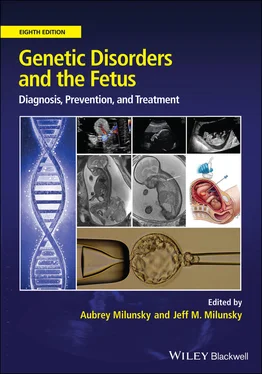Genetic Disorders and the Fetus
Здесь есть возможность читать онлайн «Genetic Disorders and the Fetus» — ознакомительный отрывок электронной книги совершенно бесплатно, а после прочтения отрывка купить полную версию. В некоторых случаях можно слушать аудио, скачать через торрент в формате fb2 и присутствует краткое содержание. Жанр: unrecognised, на английском языке. Описание произведения, (предисловие) а так же отзывы посетителей доступны на портале библиотеки ЛибКат.
- Название:Genetic Disorders and the Fetus
- Автор:
- Жанр:
- Год:неизвестен
- ISBN:нет данных
- Рейтинг книги:4 / 5. Голосов: 1
-
Избранное:Добавить в избранное
- Отзывы:
-
Ваша оценка:
- 80
- 1
- 2
- 3
- 4
- 5
Genetic Disorders and the Fetus: краткое содержание, описание и аннотация
Предлагаем к чтению аннотацию, описание, краткое содержание или предисловие (зависит от того, что написал сам автор книги «Genetic Disorders and the Fetus»). Если вы не нашли необходимую информацию о книге — напишите в комментариях, мы постараемся отыскать её.
Genetic Disorders and the Fetus — читать онлайн ознакомительный отрывок
Ниже представлен текст книги, разбитый по страницам. Система сохранения места последней прочитанной страницы, позволяет с удобством читать онлайн бесплатно книгу «Genetic Disorders and the Fetus», без необходимости каждый раз заново искать на чём Вы остановились. Поставьте закладку, и сможете в любой момент перейти на страницу, на которой закончили чтение.
Интервал:
Закладка:
Developmental considerations in confined placental mosaicism
Most of our knowledge of CPM stems from cases based on CVS. CPM is detected in 1–2 percent of pregnancies undergoing CVS, most commonly in the form of trisomy mosaicism. 57 , 66 – 68Low levels of trisomy confined to the placenta typically do not have a significant effect on fetal growth and development. Although high levels of trisomy will generally affect placental function, chromosomal abnormalities that may be lethal to the fetus are often tolerated to some degree when confined to the placenta. For example, trisomy 16 can be present in very high levels in the placenta as long as the fetus is entirely (or mostly) diploid. 69Placentas associated with CPM16 are small and there is almost always FGR, as well as an increased risk for malformations, maternal PE, and PTB. 69 , 70Importantly though, the babies born in conjunction with CPM16 typically do quite well after birth once separated from the abnormal placenta. 71 , 72
The level and distribution of the abnormal cells depends, in part, on how and when the mosaicism arose in development. 73Selection may also favor contribution of diploid cells to the embryo. 74Furthermore, some trisomies may be tolerated in the inner core of the villi, but not in the trophoblast component (e.g. trisomy 8). The fact that trisomy may be present at low levels or patchy in its distribution 55 , 65(due to independent clonal development of each of the ∼50–70 villous trees) can lead to apparent “false‐positive” and “false‐negative” diagnostic results using CVS. CPM has been identified using NIPT testing. The level of trisomy detected by NIPT, compared with CVS, should represent more of an average across the placental trophoblast. 75 , 76Surprisingly though, NIPT has also missed CPM even when high levels of placental trisomy were present. 77 , 78This is possibly explained by trisomy‐specific differences in trophoblast shedding into maternal circulation 76or by absence of the trisomy from incorporation into the syncytiotrophoblast and EVTs, from which the “fetal” DNA likely originates.
Imprinting and fetal growth restriction
Disruption of imprinted genes, those differentially expressed depending on parental origin, has been investigated in FGR due to their important role in the placenta and in regulation of growth. Classic examples of the growth effects of imprinted genes in humans are the Beckwith–Wiedemann syndrome (BWS) and SRS that are associated with overgrowth and growth restriction, respectively. 79BWS is caused by alterations of the 11p15.5 region, which includes at least eight imprinted genes organized into two domains. Growth restriction in SRS has been associated with epimutations leading to reduced IGF2 expression, as well as uniparental disomy and chromosomal rearrangements involving chromosome 7 including the MEST/PEG1 and/or the GRB10 regions. 80 , 81
Reduced fetal growth has been associated with placental changes in DNA methylation at several imprinted differentially methylated regions (DMRs), including those associated with PLAGL1 , PEG10 , H19/IGF2 , and ZNF331 . 82 – 90However, the reported changes in DNA methylation at imprinted DMRs have typically been of small magnitude and have not always been reproduced in other studies. Many studies have used SGA (<10th percentile) as a surrogate for FGR, a potential source of confusion, and many affected pregnancies deliver preterm or in association with PE, which could confound results. Furthermore, it is not clear if altered expression of imprinted genes is a cause of FGR or a compensatory effect of other defects. Larger sample sizes with stricter phenotypic criteria may help clarify the relationship between altered placental imprinting and FGR.
Preeclampsia
Maternal PE frequently occurs with FGR and shares many similar pathologic features. 91 , 92PE is part of the spectrum of hypertensive disorders in pregnancy and is typically defined by new‐onset maternal hypertension plus proteinuria after 20 weeks of gestation. As proteinuria measurements can be unreliable, 93maternal hypertension in conjunction with other features, including FGR, may alternatively be used for diagnosis. 94Early‐onset PE (EOPE), defined as onset <34 weeks of gestational age, is generally more severe and more commonly associated with FGR than late‐onset PE (LOPE). 95These appear to be distinct entities with placental pathology playing a greater role in EOPE. 96Gene expression changes have also been used to demonstrate heterogeneity among PE‐associated placentas, with only a subset showing alterations in classical markers of angiogenesis, such as sFLT‐1 and sENG. 97 – 100
Preeclamptic placentas exhibit areas of syncytial knots (clusters of pre‐apoptotic/apoptotic nuclei) and areas of necrosis associated with loss of the syncytial trophoblast microvillous membranes (STMBs). 101These STMB fragments are released into the mother's blood and have disrupting effects on the maternal endothelium. 102Correspondingly, increased maternal serum levels of cell‐free fetal (i.e. placental) DNA have been reported in PE; however, this may not be predictive after accounting for associated maternal characteristics. 103Furthermore, measuring the ratio of fetal/placental to maternal cell‐free DNA may have limited predictive power for PE as the maternal cell‐free DNA may also increase in these pregnancies. 104
Early diagnosis of preeclampsia
Early identification of at‐risk pregnancies can improve outcomes through more careful monitoring and early intervention, and thus there is great interest in determining whether there are clinically relevant and assessable markers of this risk to aid early intervention. Administration of low‐dose aspirin prior to 16 weeks of gestation has been linked to reduced risk for PE. 105 , 106Once symptoms occur, antihypertensive and/or anticonvulsant medication may be prescribed, although ultimately only delivery of the baby can cure the disease.
A number of biomarkers quantifiable in maternal blood have been investigated for utility in prediction of PE. An increase in sFLT‐1 and decrease of free vascular endothelial growth factor (VEGF) and PlGF are found in the blood of some women in the first trimester prior to the onset of PE. 107 , 108Abnormal levels of endoglin (involved in vascular remodeling) have also been observed, and it has been suggested that PE may be the result of an imbalance between pro‐ and antiangiogenic factors. 109Other factors that have been reported as altered in the serum of pregnant women with or at risk of PE include leptin, ADAM12, PP13, PlGF, PAPP‐A, and inhibin‐A. A screening approach using maternal risk factors (e.g. advanced maternal age, increased weight, previous pregnancy with PE), combined with the uterine artery pulsatility index, mean arterial pressure, and maternal serum markers (PlGF and PAPP‐A), has been reported to detect 95 percent of EOPE with a 5 percent false‐positive rate. 110As all associated biophysical and serum markers are correlated with each other in PE, this needs to be accounted for in the models. It is important to appreciate that the factors contributing to PE may vary by population, and this model needs to be validated in other populations. Furthermore, the predictive value for LOPE is much lower than for the more severe early‐onset form. These factors may explain why other studies suggest less clear predictive benefits of individual serum markers, although combinations of markers may prove useful for early screening. 111 , 112
Genetics of preeclampsia
An effect of fetal genotype on PE risk is demonstrated by the high risk associated with some human trisomies and mutations in rare cases of familial PE. PE is associated with trisomy 13 and 16 but not trisomy 18 or 21. 113 – 116In fact, a reduction in the risk of PE was observed in a large study of trisomy 21 (relative risk of 0.19). 115One in four pregnancies surviving past 20 weeks with trisomy 16 confined to the placental tissues is associated with PE (mostly EOPE). 69 , 70The varying risk for PE with different trisomies likely reflects distinct effects on placental development. In trisomy 21, both placenta and fetus are normally sized and show normal 78blood flow by Doppler ultrasound. 117 – 119However, trisomy 21 has a deficiency in formation of the syncytiotrophoblast, 117 , 118which could lower the risk of PE because of a reduction in syncytiotrophoblast apoptosis.
Читать дальшеИнтервал:
Закладка:
Похожие книги на «Genetic Disorders and the Fetus»
Представляем Вашему вниманию похожие книги на «Genetic Disorders and the Fetus» списком для выбора. Мы отобрали схожую по названию и смыслу литературу в надежде предоставить читателям больше вариантов отыскать новые, интересные, ещё непрочитанные произведения.
Обсуждение, отзывы о книге «Genetic Disorders and the Fetus» и просто собственные мнения читателей. Оставьте ваши комментарии, напишите, что Вы думаете о произведении, его смысле или главных героях. Укажите что конкретно понравилось, а что нет, и почему Вы так считаете.












